University: Business Case for Nettavisen DDBM Investment - MIS782
VerifiedAdded on 2023/03/20
|26
|6195
|66
Report
AI Summary
This report presents a business case for a Data-Driven Business Model (DDBM) investment opportunity for Nettavisen, an online news publisher. It explores DDBM-driven revenue generation ideas, emphasizing product service differentiation and data acquisition techniques. The report identifies key data sources, activities, and monetization strategies, while also addressing potential barriers to implementation. Two implementation options are presented: a two-step process and a pilot implementation plan, each accompanied by risk assessments and cost-benefit analyses. The analysis includes a detailed cost-benefit analysis, break-even analysis and risk register table. The report concludes with a recommendation for the best implementation approach and a high-level project plan, providing a comprehensive overview of the investment opportunity and its potential benefits for Nettavisen.

OPPORTUNITY FOR FURTHER INVESTMENT
Opportunity for further investment
Name of the Student
Name of the University
Author’s Note:
Opportunity for further investment
Name of the Student
Name of the University
Author’s Note:
Paraphrase This Document
Need a fresh take? Get an instant paraphrase of this document with our AI Paraphraser
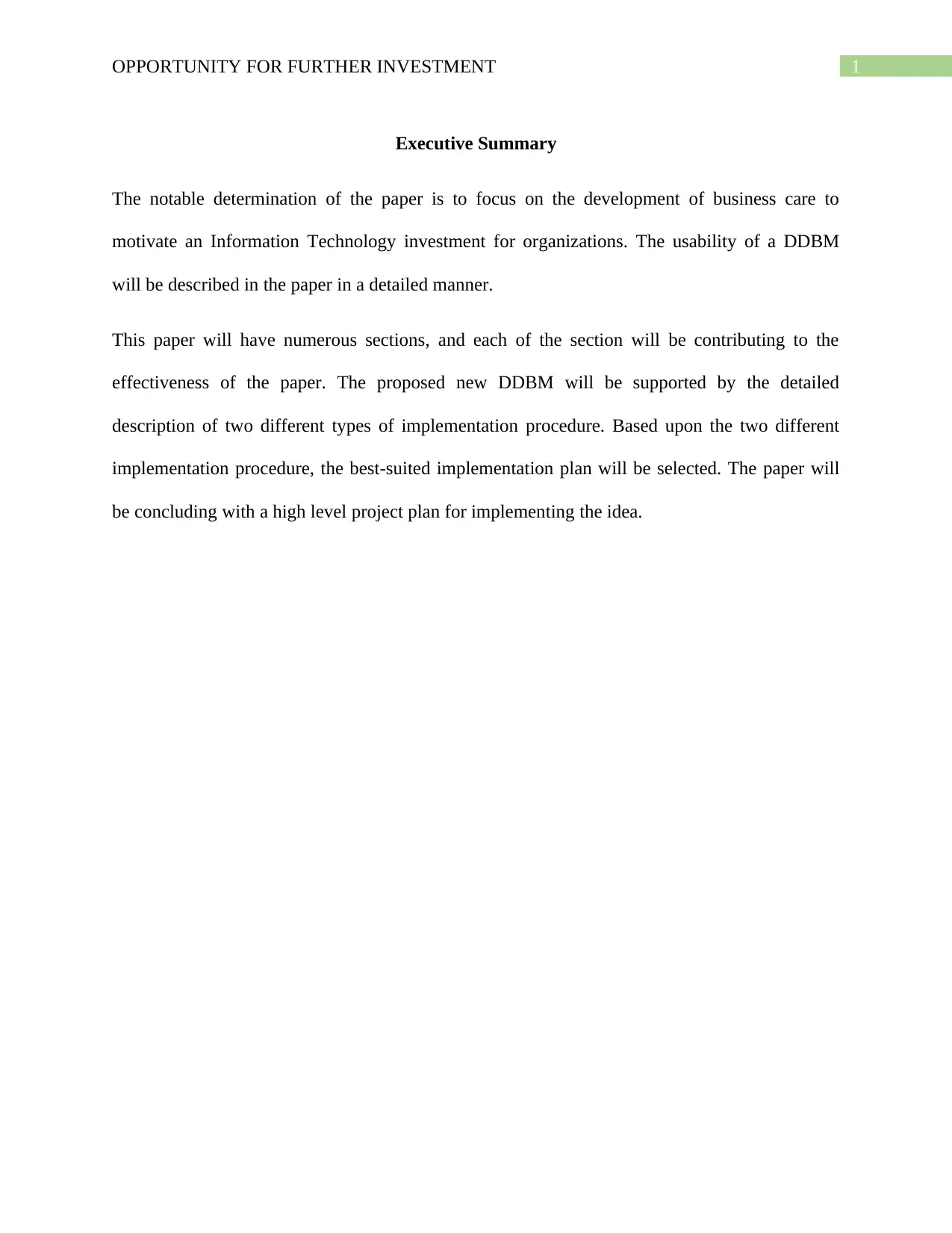
1OPPORTUNITY FOR FURTHER INVESTMENT
Executive Summary
The notable determination of the paper is to focus on the development of business care to
motivate an Information Technology investment for organizations. The usability of a DDBM
will be described in the paper in a detailed manner.
This paper will have numerous sections, and each of the section will be contributing to the
effectiveness of the paper. The proposed new DDBM will be supported by the detailed
description of two different types of implementation procedure. Based upon the two different
implementation procedure, the best-suited implementation plan will be selected. The paper will
be concluding with a high level project plan for implementing the idea.
Executive Summary
The notable determination of the paper is to focus on the development of business care to
motivate an Information Technology investment for organizations. The usability of a DDBM
will be described in the paper in a detailed manner.
This paper will have numerous sections, and each of the section will be contributing to the
effectiveness of the paper. The proposed new DDBM will be supported by the detailed
description of two different types of implementation procedure. Based upon the two different
implementation procedure, the best-suited implementation plan will be selected. The paper will
be concluding with a high level project plan for implementing the idea.
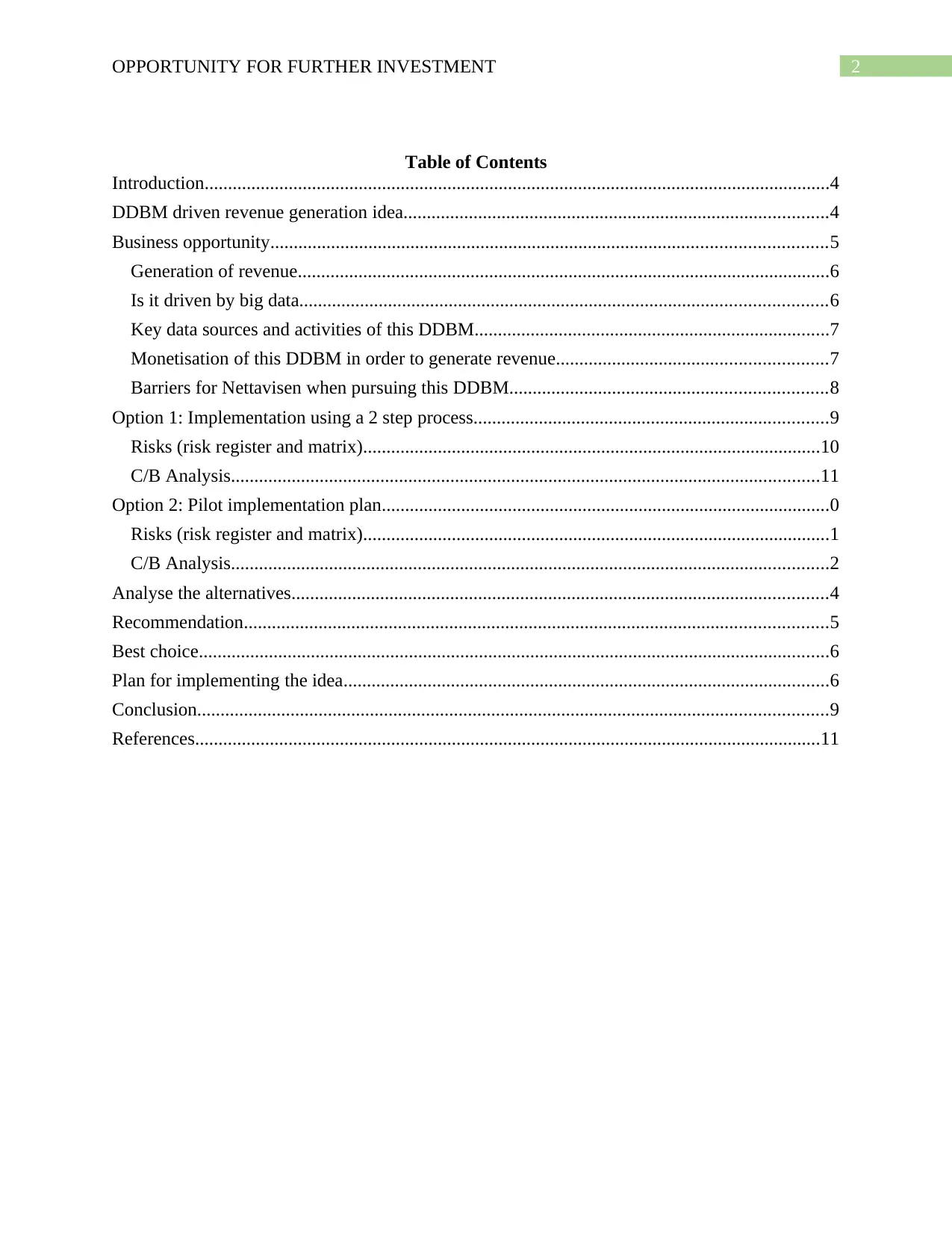
2OPPORTUNITY FOR FURTHER INVESTMENT
Table of Contents
Introduction......................................................................................................................................4
DDBM driven revenue generation idea...........................................................................................4
Business opportunity.......................................................................................................................5
Generation of revenue..................................................................................................................6
Is it driven by big data.................................................................................................................6
Key data sources and activities of this DDBM............................................................................7
Monetisation of this DDBM in order to generate revenue..........................................................7
Barriers for Nettavisen when pursuing this DDBM....................................................................8
Option 1: Implementation using a 2 step process............................................................................9
Risks (risk register and matrix)..................................................................................................10
C/B Analysis..............................................................................................................................11
Option 2: Pilot implementation plan................................................................................................0
Risks (risk register and matrix)....................................................................................................1
C/B Analysis................................................................................................................................2
Analyse the alternatives...................................................................................................................4
Recommendation.............................................................................................................................5
Best choice.......................................................................................................................................6
Plan for implementing the idea........................................................................................................6
Conclusion.......................................................................................................................................9
References......................................................................................................................................11
Table of Contents
Introduction......................................................................................................................................4
DDBM driven revenue generation idea...........................................................................................4
Business opportunity.......................................................................................................................5
Generation of revenue..................................................................................................................6
Is it driven by big data.................................................................................................................6
Key data sources and activities of this DDBM............................................................................7
Monetisation of this DDBM in order to generate revenue..........................................................7
Barriers for Nettavisen when pursuing this DDBM....................................................................8
Option 1: Implementation using a 2 step process............................................................................9
Risks (risk register and matrix)..................................................................................................10
C/B Analysis..............................................................................................................................11
Option 2: Pilot implementation plan................................................................................................0
Risks (risk register and matrix)....................................................................................................1
C/B Analysis................................................................................................................................2
Analyse the alternatives...................................................................................................................4
Recommendation.............................................................................................................................5
Best choice.......................................................................................................................................6
Plan for implementing the idea........................................................................................................6
Conclusion.......................................................................................................................................9
References......................................................................................................................................11
⊘ This is a preview!⊘
Do you want full access?
Subscribe today to unlock all pages.

Trusted by 1+ million students worldwide
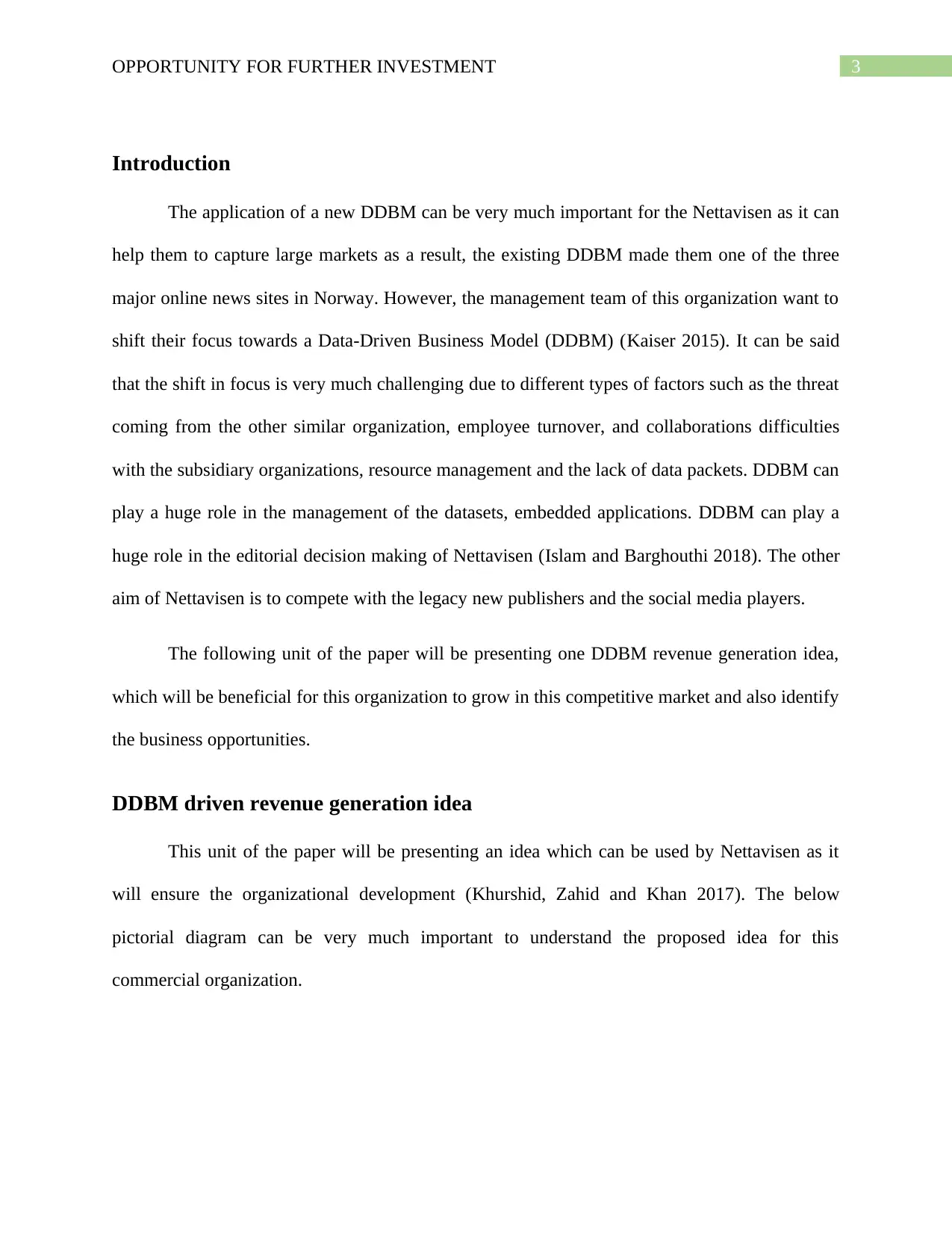
3OPPORTUNITY FOR FURTHER INVESTMENT
Introduction
The application of a new DDBM can be very much important for the Nettavisen as it can
help them to capture large markets as a result, the existing DDBM made them one of the three
major online news sites in Norway. However, the management team of this organization want to
shift their focus towards a Data-Driven Business Model (DDBM) (Kaiser 2015). It can be said
that the shift in focus is very much challenging due to different types of factors such as the threat
coming from the other similar organization, employee turnover, and collaborations difficulties
with the subsidiary organizations, resource management and the lack of data packets. DDBM can
play a huge role in the management of the datasets, embedded applications. DDBM can play a
huge role in the editorial decision making of Nettavisen (Islam and Barghouthi 2018). The other
aim of Nettavisen is to compete with the legacy new publishers and the social media players.
The following unit of the paper will be presenting one DDBM revenue generation idea,
which will be beneficial for this organization to grow in this competitive market and also identify
the business opportunities.
DDBM driven revenue generation idea
This unit of the paper will be presenting an idea which can be used by Nettavisen as it
will ensure the organizational development (Khurshid, Zahid and Khan 2017). The below
pictorial diagram can be very much important to understand the proposed idea for this
commercial organization.
Introduction
The application of a new DDBM can be very much important for the Nettavisen as it can
help them to capture large markets as a result, the existing DDBM made them one of the three
major online news sites in Norway. However, the management team of this organization want to
shift their focus towards a Data-Driven Business Model (DDBM) (Kaiser 2015). It can be said
that the shift in focus is very much challenging due to different types of factors such as the threat
coming from the other similar organization, employee turnover, and collaborations difficulties
with the subsidiary organizations, resource management and the lack of data packets. DDBM can
play a huge role in the management of the datasets, embedded applications. DDBM can play a
huge role in the editorial decision making of Nettavisen (Islam and Barghouthi 2018). The other
aim of Nettavisen is to compete with the legacy new publishers and the social media players.
The following unit of the paper will be presenting one DDBM revenue generation idea,
which will be beneficial for this organization to grow in this competitive market and also identify
the business opportunities.
DDBM driven revenue generation idea
This unit of the paper will be presenting an idea which can be used by Nettavisen as it
will ensure the organizational development (Khurshid, Zahid and Khan 2017). The below
pictorial diagram can be very much important to understand the proposed idea for this
commercial organization.
Paraphrase This Document
Need a fresh take? Get an instant paraphrase of this document with our AI Paraphraser
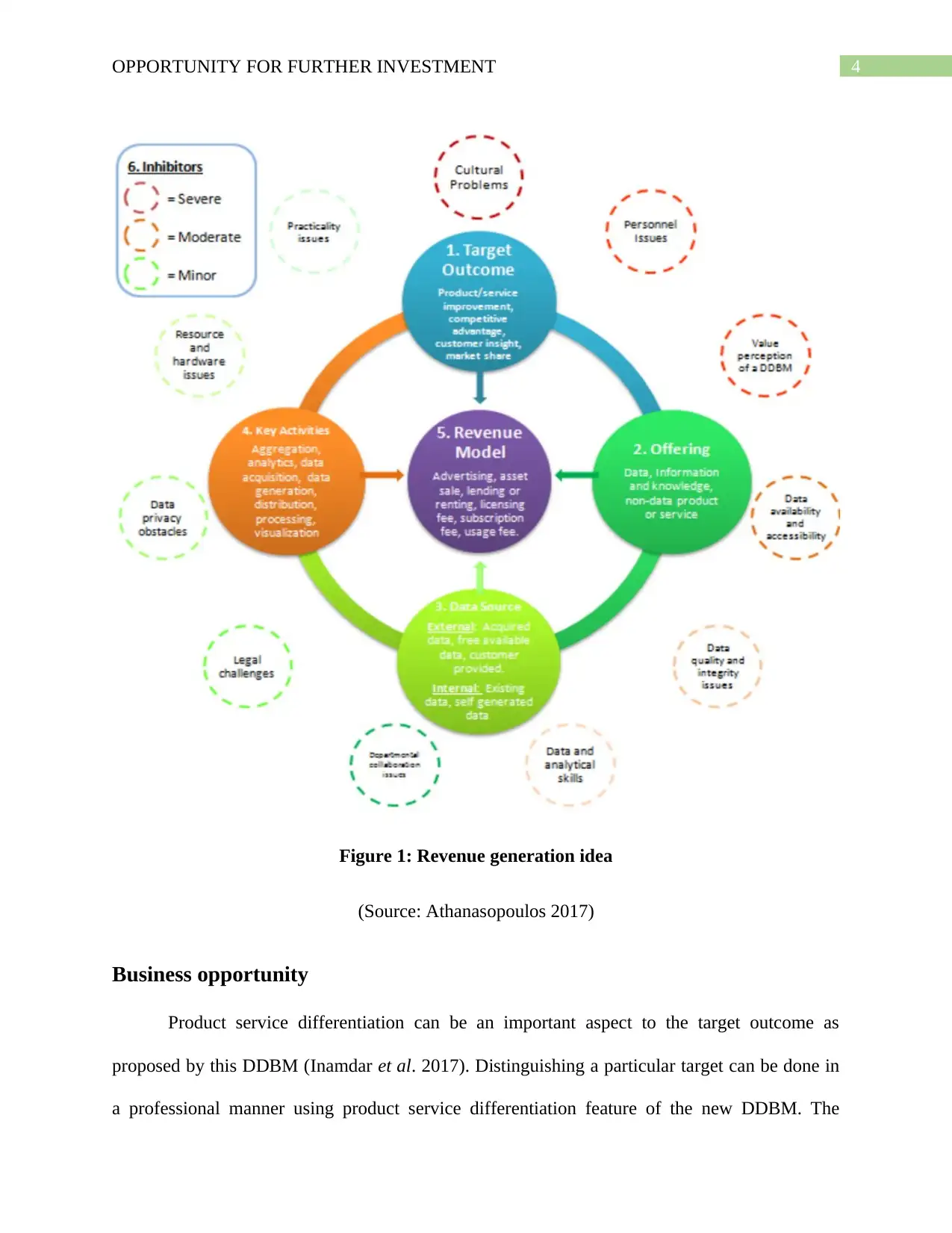
4OPPORTUNITY FOR FURTHER INVESTMENT
Figure 1: Revenue generation idea
(Source: Athanasopoulos 2017)
Business opportunity
Product service differentiation can be an important aspect to the target outcome as
proposed by this DDBM (Inamdar et al. 2017). Distinguishing a particular target can be done in
a professional manner using product service differentiation feature of the new DDBM. The
Figure 1: Revenue generation idea
(Source: Athanasopoulos 2017)
Business opportunity
Product service differentiation can be an important aspect to the target outcome as
proposed by this DDBM (Inamdar et al. 2017). Distinguishing a particular target can be done in
a professional manner using product service differentiation feature of the new DDBM. The
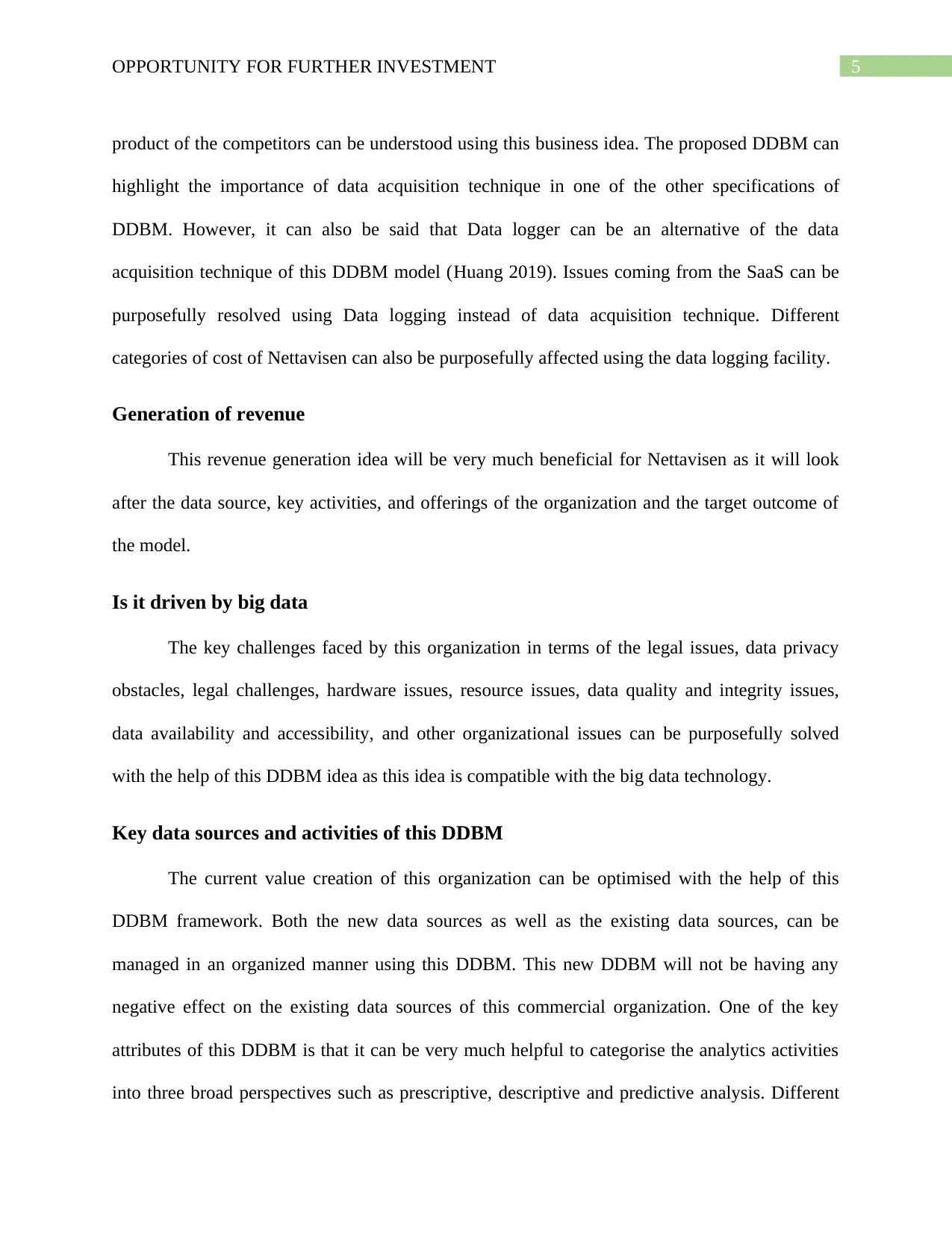
5OPPORTUNITY FOR FURTHER INVESTMENT
product of the competitors can be understood using this business idea. The proposed DDBM can
highlight the importance of data acquisition technique in one of the other specifications of
DDBM. However, it can also be said that Data logger can be an alternative of the data
acquisition technique of this DDBM model (Huang 2019). Issues coming from the SaaS can be
purposefully resolved using Data logging instead of data acquisition technique. Different
categories of cost of Nettavisen can also be purposefully affected using the data logging facility.
Generation of revenue
This revenue generation idea will be very much beneficial for Nettavisen as it will look
after the data source, key activities, and offerings of the organization and the target outcome of
the model.
Is it driven by big data
The key challenges faced by this organization in terms of the legal issues, data privacy
obstacles, legal challenges, hardware issues, resource issues, data quality and integrity issues,
data availability and accessibility, and other organizational issues can be purposefully solved
with the help of this DDBM idea as this idea is compatible with the big data technology.
Key data sources and activities of this DDBM
The current value creation of this organization can be optimised with the help of this
DDBM framework. Both the new data sources as well as the existing data sources, can be
managed in an organized manner using this DDBM. This new DDBM will not be having any
negative effect on the existing data sources of this commercial organization. One of the key
attributes of this DDBM is that it can be very much helpful to categorise the analytics activities
into three broad perspectives such as prescriptive, descriptive and predictive analysis. Different
product of the competitors can be understood using this business idea. The proposed DDBM can
highlight the importance of data acquisition technique in one of the other specifications of
DDBM. However, it can also be said that Data logger can be an alternative of the data
acquisition technique of this DDBM model (Huang 2019). Issues coming from the SaaS can be
purposefully resolved using Data logging instead of data acquisition technique. Different
categories of cost of Nettavisen can also be purposefully affected using the data logging facility.
Generation of revenue
This revenue generation idea will be very much beneficial for Nettavisen as it will look
after the data source, key activities, and offerings of the organization and the target outcome of
the model.
Is it driven by big data
The key challenges faced by this organization in terms of the legal issues, data privacy
obstacles, legal challenges, hardware issues, resource issues, data quality and integrity issues,
data availability and accessibility, and other organizational issues can be purposefully solved
with the help of this DDBM idea as this idea is compatible with the big data technology.
Key data sources and activities of this DDBM
The current value creation of this organization can be optimised with the help of this
DDBM framework. Both the new data sources as well as the existing data sources, can be
managed in an organized manner using this DDBM. This new DDBM will not be having any
negative effect on the existing data sources of this commercial organization. One of the key
attributes of this DDBM is that it can be very much helpful to categorise the analytics activities
into three broad perspectives such as prescriptive, descriptive and predictive analysis. Different
⊘ This is a preview!⊘
Do you want full access?
Subscribe today to unlock all pages.

Trusted by 1+ million students worldwide
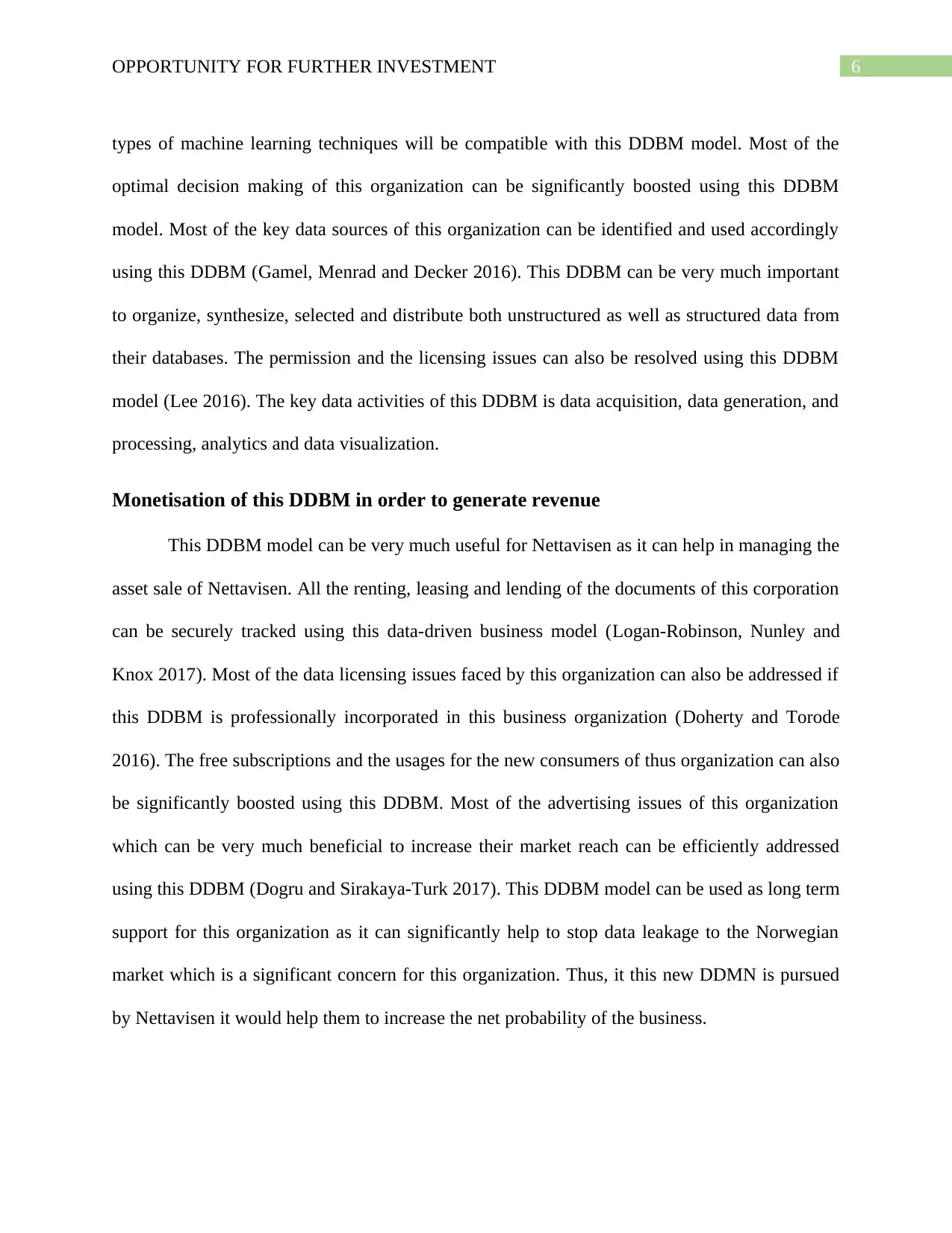
6OPPORTUNITY FOR FURTHER INVESTMENT
types of machine learning techniques will be compatible with this DDBM model. Most of the
optimal decision making of this organization can be significantly boosted using this DDBM
model. Most of the key data sources of this organization can be identified and used accordingly
using this DDBM (Gamel, Menrad and Decker 2016). This DDBM can be very much important
to organize, synthesize, selected and distribute both unstructured as well as structured data from
their databases. The permission and the licensing issues can also be resolved using this DDBM
model (Lee 2016). The key data activities of this DDBM is data acquisition, data generation, and
processing, analytics and data visualization.
Monetisation of this DDBM in order to generate revenue
This DDBM model can be very much useful for Nettavisen as it can help in managing the
asset sale of Nettavisen. All the renting, leasing and lending of the documents of this corporation
can be securely tracked using this data-driven business model (Logan-Robinson, Nunley and
Knox 2017). Most of the data licensing issues faced by this organization can also be addressed if
this DDBM is professionally incorporated in this business organization (Doherty and Torode
2016). The free subscriptions and the usages for the new consumers of thus organization can also
be significantly boosted using this DDBM. Most of the advertising issues of this organization
which can be very much beneficial to increase their market reach can be efficiently addressed
using this DDBM (Dogru and Sirakaya-Turk 2017). This DDBM model can be used as long term
support for this organization as it can significantly help to stop data leakage to the Norwegian
market which is a significant concern for this organization. Thus, it this new DDMN is pursued
by Nettavisen it would help them to increase the net probability of the business.
types of machine learning techniques will be compatible with this DDBM model. Most of the
optimal decision making of this organization can be significantly boosted using this DDBM
model. Most of the key data sources of this organization can be identified and used accordingly
using this DDBM (Gamel, Menrad and Decker 2016). This DDBM can be very much important
to organize, synthesize, selected and distribute both unstructured as well as structured data from
their databases. The permission and the licensing issues can also be resolved using this DDBM
model (Lee 2016). The key data activities of this DDBM is data acquisition, data generation, and
processing, analytics and data visualization.
Monetisation of this DDBM in order to generate revenue
This DDBM model can be very much useful for Nettavisen as it can help in managing the
asset sale of Nettavisen. All the renting, leasing and lending of the documents of this corporation
can be securely tracked using this data-driven business model (Logan-Robinson, Nunley and
Knox 2017). Most of the data licensing issues faced by this organization can also be addressed if
this DDBM is professionally incorporated in this business organization (Doherty and Torode
2016). The free subscriptions and the usages for the new consumers of thus organization can also
be significantly boosted using this DDBM. Most of the advertising issues of this organization
which can be very much beneficial to increase their market reach can be efficiently addressed
using this DDBM (Dogru and Sirakaya-Turk 2017). This DDBM model can be used as long term
support for this organization as it can significantly help to stop data leakage to the Norwegian
market which is a significant concern for this organization. Thus, it this new DDMN is pursued
by Nettavisen it would help them to increase the net probability of the business.
Paraphrase This Document
Need a fresh take? Get an instant paraphrase of this document with our AI Paraphraser
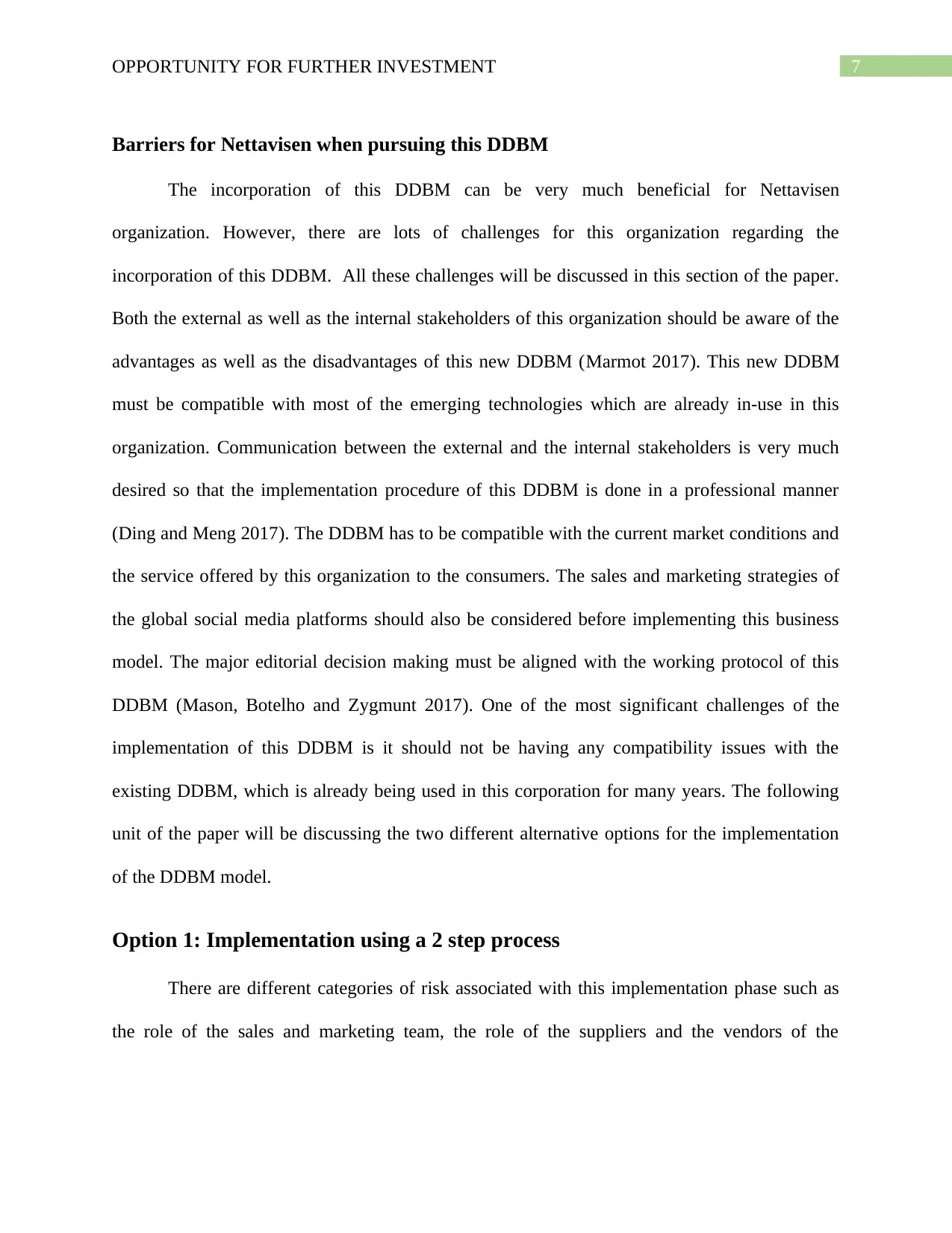
7OPPORTUNITY FOR FURTHER INVESTMENT
Barriers for Nettavisen when pursuing this DDBM
The incorporation of this DDBM can be very much beneficial for Nettavisen
organization. However, there are lots of challenges for this organization regarding the
incorporation of this DDBM. All these challenges will be discussed in this section of the paper.
Both the external as well as the internal stakeholders of this organization should be aware of the
advantages as well as the disadvantages of this new DDBM (Marmot 2017). This new DDBM
must be compatible with most of the emerging technologies which are already in-use in this
organization. Communication between the external and the internal stakeholders is very much
desired so that the implementation procedure of this DDBM is done in a professional manner
(Ding and Meng 2017). The DDBM has to be compatible with the current market conditions and
the service offered by this organization to the consumers. The sales and marketing strategies of
the global social media platforms should also be considered before implementing this business
model. The major editorial decision making must be aligned with the working protocol of this
DDBM (Mason, Botelho and Zygmunt 2017). One of the most significant challenges of the
implementation of this DDBM is it should not be having any compatibility issues with the
existing DDBM, which is already being used in this corporation for many years. The following
unit of the paper will be discussing the two different alternative options for the implementation
of the DDBM model.
Option 1: Implementation using a 2 step process
There are different categories of risk associated with this implementation phase such as
the role of the sales and marketing team, the role of the suppliers and the vendors of the
Barriers for Nettavisen when pursuing this DDBM
The incorporation of this DDBM can be very much beneficial for Nettavisen
organization. However, there are lots of challenges for this organization regarding the
incorporation of this DDBM. All these challenges will be discussed in this section of the paper.
Both the external as well as the internal stakeholders of this organization should be aware of the
advantages as well as the disadvantages of this new DDBM (Marmot 2017). This new DDBM
must be compatible with most of the emerging technologies which are already in-use in this
organization. Communication between the external and the internal stakeholders is very much
desired so that the implementation procedure of this DDBM is done in a professional manner
(Ding and Meng 2017). The DDBM has to be compatible with the current market conditions and
the service offered by this organization to the consumers. The sales and marketing strategies of
the global social media platforms should also be considered before implementing this business
model. The major editorial decision making must be aligned with the working protocol of this
DDBM (Mason, Botelho and Zygmunt 2017). One of the most significant challenges of the
implementation of this DDBM is it should not be having any compatibility issues with the
existing DDBM, which is already being used in this corporation for many years. The following
unit of the paper will be discussing the two different alternative options for the implementation
of the DDBM model.
Option 1: Implementation using a 2 step process
There are different categories of risk associated with this implementation phase such as
the role of the sales and marketing team, the role of the suppliers and the vendors of the
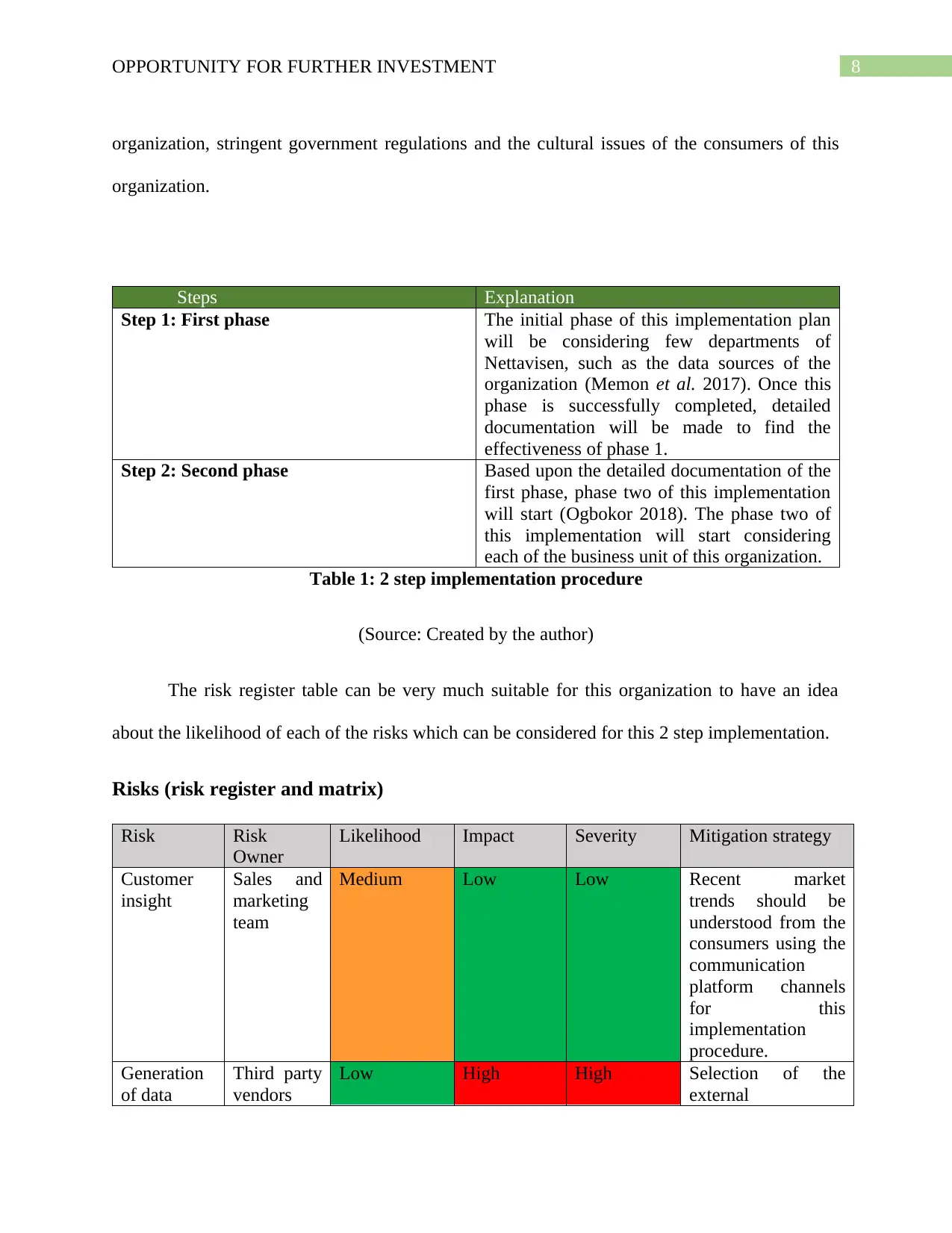
8OPPORTUNITY FOR FURTHER INVESTMENT
organization, stringent government regulations and the cultural issues of the consumers of this
organization.
Steps Explanation
Step 1: First phase The initial phase of this implementation plan
will be considering few departments of
Nettavisen, such as the data sources of the
organization (Memon et al. 2017). Once this
phase is successfully completed, detailed
documentation will be made to find the
effectiveness of phase 1.
Step 2: Second phase Based upon the detailed documentation of the
first phase, phase two of this implementation
will start (Ogbokor 2018). The phase two of
this implementation will start considering
each of the business unit of this organization.
Table 1: 2 step implementation procedure
(Source: Created by the author)
The risk register table can be very much suitable for this organization to have an idea
about the likelihood of each of the risks which can be considered for this 2 step implementation.
Risks (risk register and matrix)
Risk Risk
Owner
Likelihood Impact Severity Mitigation strategy
Customer
insight
Sales and
marketing
team
Medium Low Low Recent market
trends should be
understood from the
consumers using the
communication
platform channels
for this
implementation
procedure.
Generation
of data
Third party
vendors
Low High High Selection of the
external
organization, stringent government regulations and the cultural issues of the consumers of this
organization.
Steps Explanation
Step 1: First phase The initial phase of this implementation plan
will be considering few departments of
Nettavisen, such as the data sources of the
organization (Memon et al. 2017). Once this
phase is successfully completed, detailed
documentation will be made to find the
effectiveness of phase 1.
Step 2: Second phase Based upon the detailed documentation of the
first phase, phase two of this implementation
will start (Ogbokor 2018). The phase two of
this implementation will start considering
each of the business unit of this organization.
Table 1: 2 step implementation procedure
(Source: Created by the author)
The risk register table can be very much suitable for this organization to have an idea
about the likelihood of each of the risks which can be considered for this 2 step implementation.
Risks (risk register and matrix)
Risk Risk
Owner
Likelihood Impact Severity Mitigation strategy
Customer
insight
Sales and
marketing
team
Medium Low Low Recent market
trends should be
understood from the
consumers using the
communication
platform channels
for this
implementation
procedure.
Generation
of data
Third party
vendors
Low High High Selection of the
external
⊘ This is a preview!⊘
Do you want full access?
Subscribe today to unlock all pages.

Trusted by 1+ million students worldwide
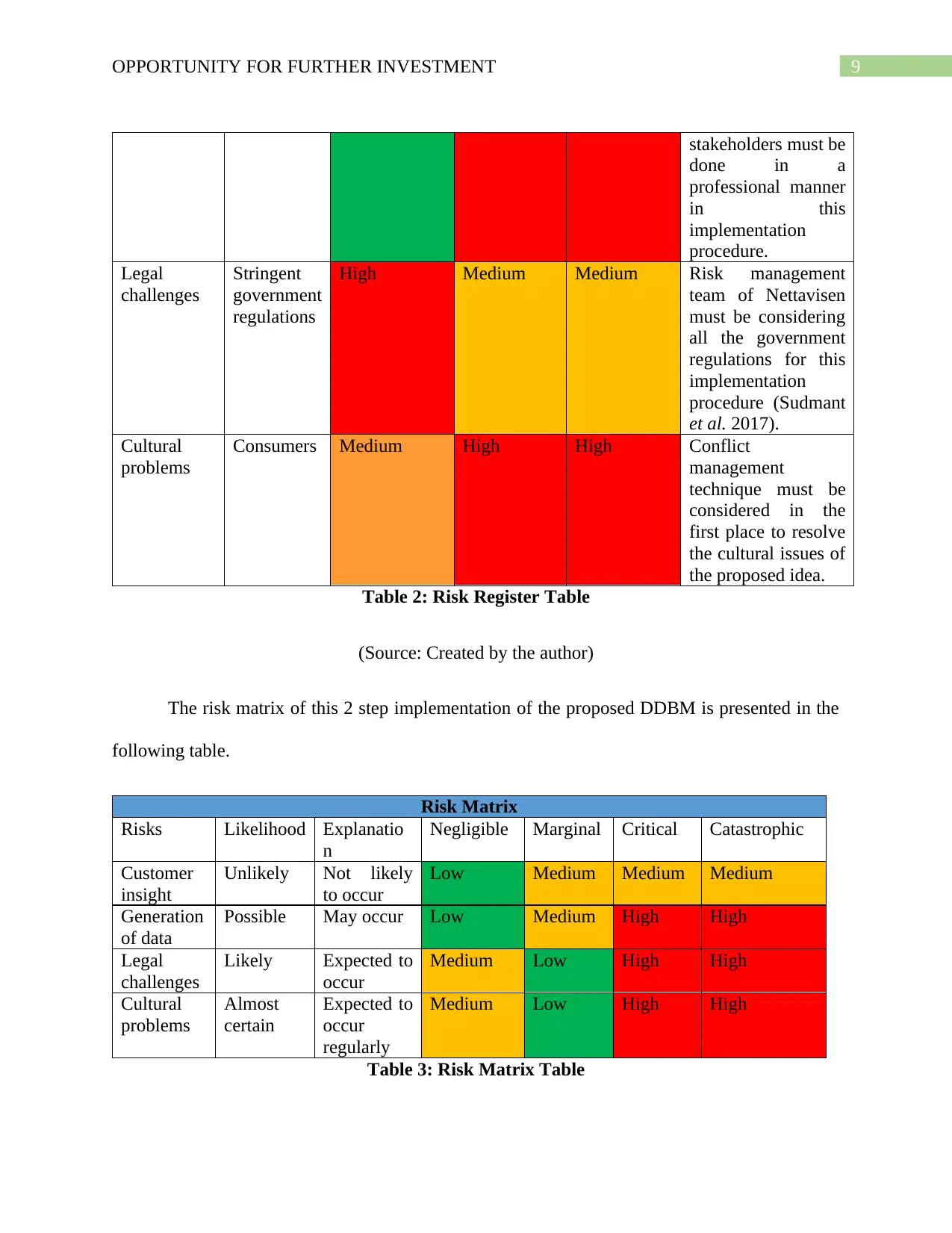
9OPPORTUNITY FOR FURTHER INVESTMENT
stakeholders must be
done in a
professional manner
in this
implementation
procedure.
Legal
challenges
Stringent
government
regulations
High Medium Medium Risk management
team of Nettavisen
must be considering
all the government
regulations for this
implementation
procedure (Sudmant
et al. 2017).
Cultural
problems
Consumers Medium High High Conflict
management
technique must be
considered in the
first place to resolve
the cultural issues of
the proposed idea.
Table 2: Risk Register Table
(Source: Created by the author)
The risk matrix of this 2 step implementation of the proposed DDBM is presented in the
following table.
Risk Matrix
Risks Likelihood Explanatio
n
Negligible Marginal Critical Catastrophic
Customer
insight
Unlikely Not likely
to occur
Low Medium Medium Medium
Generation
of data
Possible May occur Low Medium High High
Legal
challenges
Likely Expected to
occur
Medium Low High High
Cultural
problems
Almost
certain
Expected to
occur
regularly
Medium Low High High
Table 3: Risk Matrix Table
stakeholders must be
done in a
professional manner
in this
implementation
procedure.
Legal
challenges
Stringent
government
regulations
High Medium Medium Risk management
team of Nettavisen
must be considering
all the government
regulations for this
implementation
procedure (Sudmant
et al. 2017).
Cultural
problems
Consumers Medium High High Conflict
management
technique must be
considered in the
first place to resolve
the cultural issues of
the proposed idea.
Table 2: Risk Register Table
(Source: Created by the author)
The risk matrix of this 2 step implementation of the proposed DDBM is presented in the
following table.
Risk Matrix
Risks Likelihood Explanatio
n
Negligible Marginal Critical Catastrophic
Customer
insight
Unlikely Not likely
to occur
Low Medium Medium Medium
Generation
of data
Possible May occur Low Medium High High
Legal
challenges
Likely Expected to
occur
Medium Low High High
Cultural
problems
Almost
certain
Expected to
occur
regularly
Medium Low High High
Table 3: Risk Matrix Table
Paraphrase This Document
Need a fresh take? Get an instant paraphrase of this document with our AI Paraphraser
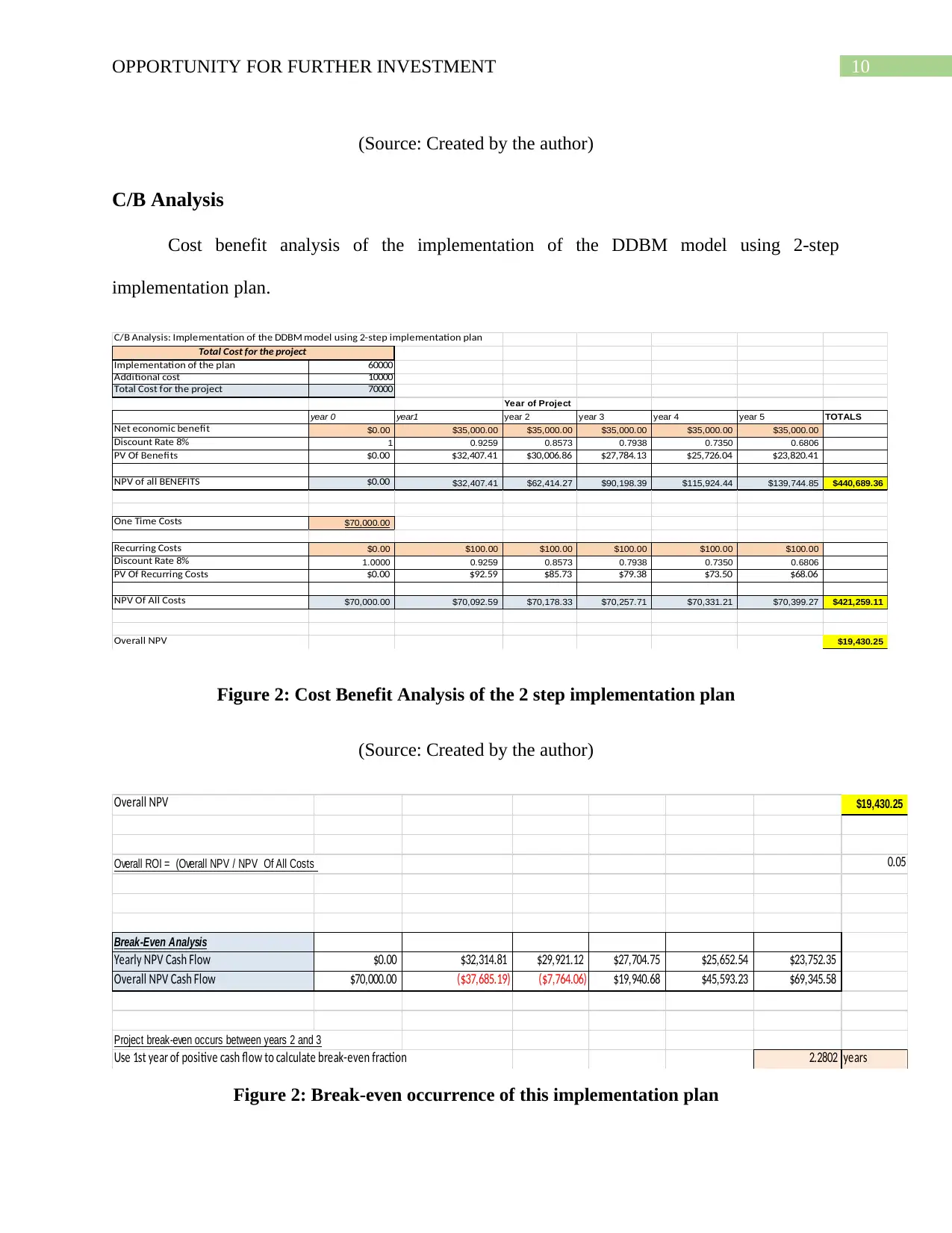
10OPPORTUNITY FOR FURTHER INVESTMENT
(Source: Created by the author)
C/B Analysis
Cost benefit analysis of the implementation of the DDBM model using 2-step
implementation plan.
C/B Analysis: Implementation of the DDBM model using 2-step implementation plan
Implementation of the plan 60000
Additional cost 10000
Total Cost for the project 70000
Year of Project
year 0 year1 year 2 year 3 year 4 year 5 TOTALS
Net economic benefit $0.00 $35,000.00 $35,000.00 $35,000.00 $35,000.00 $35,000.00
Discount Rate 8% 1 0.9259 0.8573 0.7938 0.7350 0.6806
PV Of Benefits $0.00 $32,407.41 $30,006.86 $27,784.13 $25,726.04 $23,820.41
NPV of all BENEFITS $0.00 $32,407.41 $62,414.27 $90,198.39 $115,924.44 $139,744.85 $440,689.36
One Time Costs $70,000.00
Recurring Costs $0.00 $100.00 $100.00 $100.00 $100.00 $100.00
Discount Rate 8% 1.0000 0.9259 0.8573 0.7938 0.7350 0.6806
PV Of Recurring Costs $0.00 $92.59 $85.73 $79.38 $73.50 $68.06
NPV Of All Costs $70,000.00 $70,092.59 $70,178.33 $70,257.71 $70,331.21 $70,399.27 $421,259.11
Overall NPV $19,430.25
Total Cost for the project
Figure 2: Cost Benefit Analysis of the 2 step implementation plan
(Source: Created by the author)
Overall NPV $19,430.25
Overall ROI = (Overall NPV / NPV Of All Costs 0.05
Break-Even Analysis
Yearly NPV Cash Flow $0.00 $32,314.81 $29,921.12 $27,704.75 $25,652.54 $23,752.35
Overall NPV Cash Flow $70,000.00 ($37,685.19) ($7,764.06) $19,940.68 $45,593.23 $69,345.58
Project break-even occurs between years 2 and 3
Use 1st year of positive cash flow to calculate break-even fraction 2.2802 years
Figure 2: Break-even occurrence of this implementation plan
(Source: Created by the author)
C/B Analysis
Cost benefit analysis of the implementation of the DDBM model using 2-step
implementation plan.
C/B Analysis: Implementation of the DDBM model using 2-step implementation plan
Implementation of the plan 60000
Additional cost 10000
Total Cost for the project 70000
Year of Project
year 0 year1 year 2 year 3 year 4 year 5 TOTALS
Net economic benefit $0.00 $35,000.00 $35,000.00 $35,000.00 $35,000.00 $35,000.00
Discount Rate 8% 1 0.9259 0.8573 0.7938 0.7350 0.6806
PV Of Benefits $0.00 $32,407.41 $30,006.86 $27,784.13 $25,726.04 $23,820.41
NPV of all BENEFITS $0.00 $32,407.41 $62,414.27 $90,198.39 $115,924.44 $139,744.85 $440,689.36
One Time Costs $70,000.00
Recurring Costs $0.00 $100.00 $100.00 $100.00 $100.00 $100.00
Discount Rate 8% 1.0000 0.9259 0.8573 0.7938 0.7350 0.6806
PV Of Recurring Costs $0.00 $92.59 $85.73 $79.38 $73.50 $68.06
NPV Of All Costs $70,000.00 $70,092.59 $70,178.33 $70,257.71 $70,331.21 $70,399.27 $421,259.11
Overall NPV $19,430.25
Total Cost for the project
Figure 2: Cost Benefit Analysis of the 2 step implementation plan
(Source: Created by the author)
Overall NPV $19,430.25
Overall ROI = (Overall NPV / NPV Of All Costs 0.05
Break-Even Analysis
Yearly NPV Cash Flow $0.00 $32,314.81 $29,921.12 $27,704.75 $25,652.54 $23,752.35
Overall NPV Cash Flow $70,000.00 ($37,685.19) ($7,764.06) $19,940.68 $45,593.23 $69,345.58
Project break-even occurs between years 2 and 3
Use 1st year of positive cash flow to calculate break-even fraction 2.2802 years
Figure 2: Break-even occurrence of this implementation plan

11OPPORTUNITY FOR FURTHER INVESTMENT
(Source: Created by the author)
(Source: Created by the author)
⊘ This is a preview!⊘
Do you want full access?
Subscribe today to unlock all pages.

Trusted by 1+ million students worldwide
1 out of 26
Related Documents
Your All-in-One AI-Powered Toolkit for Academic Success.
+13062052269
info@desklib.com
Available 24*7 on WhatsApp / Email
![[object Object]](/_next/static/media/star-bottom.7253800d.svg)
Unlock your academic potential
Copyright © 2020–2025 A2Z Services. All Rights Reserved. Developed and managed by ZUCOL.





